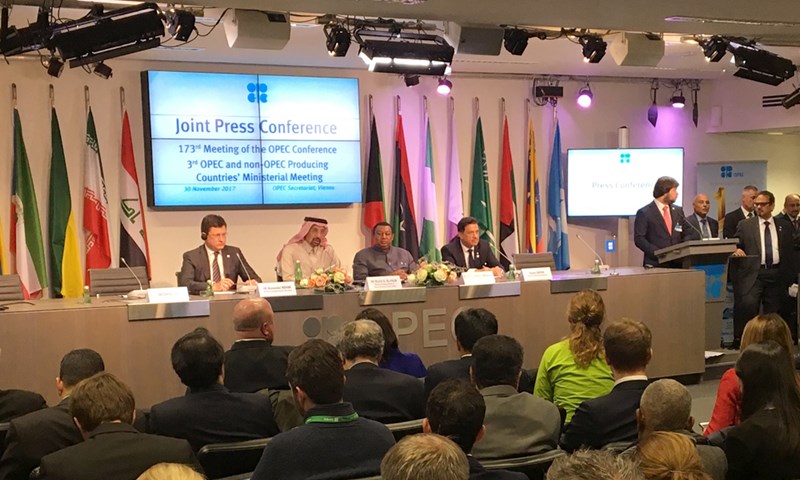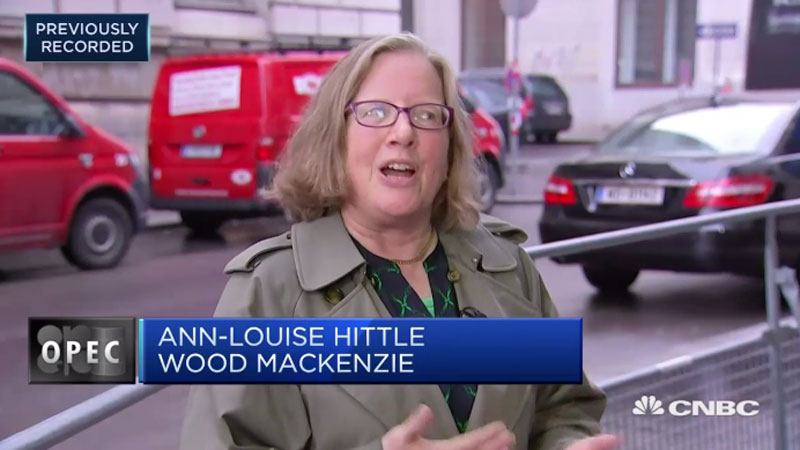OPEC extends production cuts through 2018
Brent crude prices ticked up past US$63/bbl after the decision was announced to further extend cuts by 9 months
1 minute read
UPDATE: This week's OPEC meeting in Vienna culminated today in a smooth rollover of production cuts through 2018, with a potential escape clause set for their June meeting. OPEC and non-OPEC countries – notably Russia – agreed to keep the current production restraint in place through 2018, which matches the base case assumption for our price forecast from July 2017.
Saudi Arabia's Oil Minister Khalid al-Falih takes questions at the post-meeting press conference. (Photo credit: Anthea Pitt)
The stakes were high for OPEC. Despite the success in cutting output and follow-on price recovery, if the agreement had ended in March 2018, our forecast shows there would have been a very large 2.4 million barrels per day (b/d) year-on-year increase in total world oil supply for 2018. That would have led to a persistent oversupply for every quarter of 2018.

Ann-Louise Hittle
Vice President, Oil Markets
Ann-Louise directs our Macro Oils Service and is a frequent contributor to numerous industry publications.
Latest articles by Ann-Louise
-
The Edge
Upstream’s mounting challenge to deliver future oil supply
-
Opinion
Price swings ripple through North American oil markets
-
Opinion
Oil and refining market implications of Israel’s strike on Iran
-
Opinion
What is the impact of US tariffs on oil and refining?
-
Opinion
What the Middle East conflict means for oil, LNG and the global economy
-
The Edge
What the Middle East conflict means for oil and LNG
With the rollover in place and the same level of adherence through 2018, we expect a 1.8 million b/d year-on-year gain in world oil supply. With the extension, the supply and demand balance tightens in H2 2018 and helps lift prices in the second half of the year. We expect a pullback in H1 2018 because of resumption of oversupply in the first two quarters.
A mid-2018 review could be warranted due to several uncertainties that could shift the fundamentals for 2018. These include political risk to oil supply, level of recovery from Libya and Nigeria, and rate of growth in US oil production during 2018. Another factor is world oil demand growth. If it is stronger than expected, it would cause the oversupply we expect in H1 2018 to shrink.
The June review allows OPEC and non-OPEC to reconsider production cuts. Our current forecast is based on oil demand growth of 1.2 million b/d in 2017 and 1.4 million b/d in 2018, but a colder than expected winter, for example, could lift Q1 2018 demand higher than projected and tighten the market.
Get the full picture for global oil markets
Macro oils long-term outlook H2 2017: the role of tight oil, OPEC, and decelerating demand growth
PREVIOUSLY: Ahead of Thursday’s OPEC meeting, Ann-Louise Hittle, Vice President, Macro Oils, commented on the likelihood of a 9-month extension of the current production restraint agreement.
Based on the early readings of the OPEC meeting, and statements from Russia's oil minister, it looks as if an agreement to extend to end-2018 is nearly concluded after talks ahead of the full session.
Ms. Hittle also spoke with CNBC about the implications across the global market, including downward pressure on oil price should the deal not be extended.
An agreement to keep production restraint from OPEC and the cooperating non-OPEC producers would match our base case assumption, made in the early July Macro Oils Monthly Update, to extend production restraint through 2018.
Without the extension, the larger increase in supply next year would lead to an implied stock build in each quarter of 2018 and put downward pressure on oil prices.
Read more in the latest news:
Bloomberg: OPEC’s Easy Win Masks Tougher Oil-Market Choices Still to Come
The Times: Opec nations agree to keep limit on oil output to end of 2018
FT: Oil production cuts set to be extended throughout 2018
Les Echos: Pétrole : les quotas de production sont prolongés jusqu'à la fin 2018








